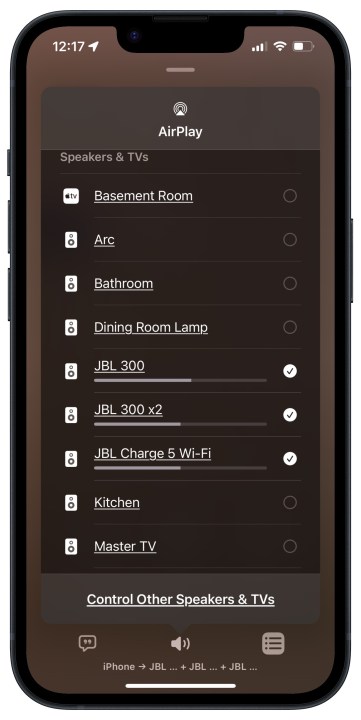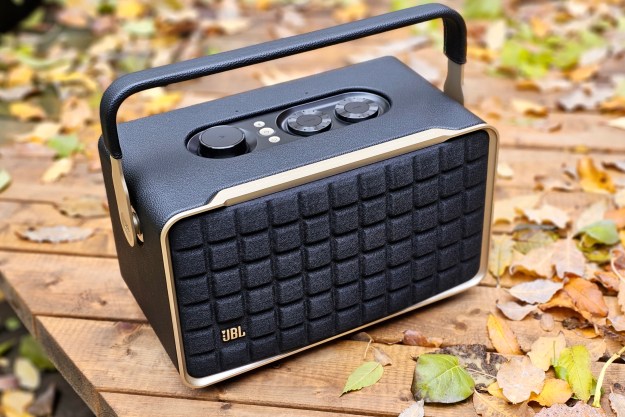
- Unique, retro design
- Easy set up
- Excellent build, top-notch materials
- Intuitive controls
- Powerful sound
- Google Assistant and Amazon Alexa
- Limited battery life
- Bass suffers at low volumes
- Awkward multiroom control
- Chromecast requires Google Assistant
JBL’s Authentics 300 portable wireless speaker (and its entire Authentics lineup) is part of the company’s somewhat late embrace of Wi-Fi-based audio. It’s almost as though 2023 rolled around and the company said, “Hey, those Sonos guys are really onto something. We should do that, too.”
- JBL Authentics 300: design
- JBL Authentics 300: controls and indicators
- JBL Authentics 300: Setup and connections
- JBL Authentics 300: using the JBL One app for music streaming
- JBL Authentics 300: multiroom audio
- JBL Authentics 300: smart voice assistants
- JBL Authentics 300: sound quality
- JBL Authentics 300: battery life
But instead of the copycat approach favored by Wiim (another Sonos competitor), JBL has carved its own path by leveraging its long history as one of the most influential audio brands of the 20th century. It’s a legacy that’s on full display — the Authentics 300 oozes old-school 1970s cool thanks to its stitched faux leather, gold-tone accents, and a “Quadrex” grille. It also has one very unusual feature that sets it apart from all other wireless smart speakers, including those from Sonos: it can run Amazon Alexa and Google Assistant simultaneously.
But is there more to the Authentics 300 than killer looks and a split personality? For $450, the answer had better be yes. I spent several weeks with the speaker to find out.
JBL Authentics 300: design
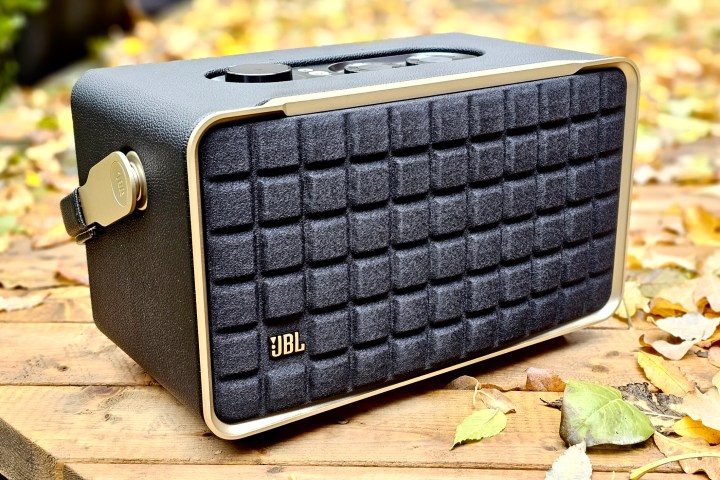
I’m not a fan of gold-toned anything, so the Authentics 300 wouldn’t be my first choice — aesthetically speaking — for a portable speaker. But there’s no denying that JBL has created a look and feel for this speaker (and its Authentics siblings) that echoes vintage 70s audio and I suspect that will earn it plenty of admirers.
The leather might be synthetic, but you’d be hard-pressed to tell just by looking at it. The so-called Quadrex grille definitely recalls vintage JBL speakers, but instead of the structured, open-cell foam used in the 70s, it uses acoustic fabric over a rigid plastic lattice.
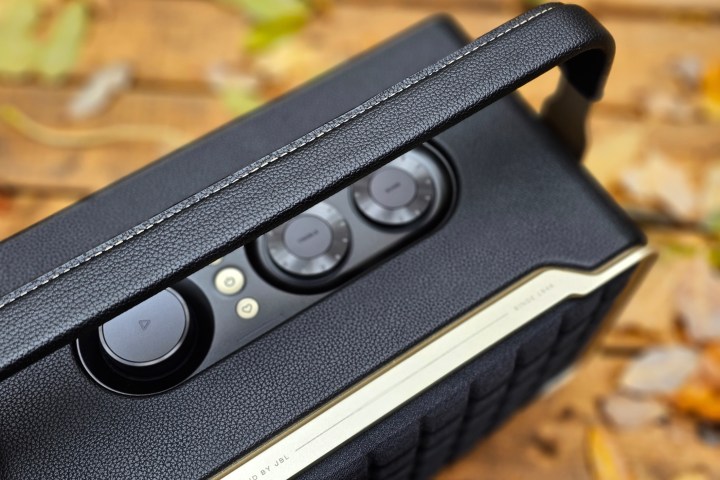
The Authentics 300 is built with impressive robustness. It doesn’t just feel substantial — though at 10.8 pounds it’s plenty hefty — it feels solid. Like it could take a blow from a baseball bat and survive. (Please don’t try that.) The speaker’s four rubber feet give it a firm footing on a variety of surfaces, but just make sure they’re flat — the downward-firing passive bass radiator won’t take kindly to pointy objects.
The aluminum folding carry handle is just as sturdy, if not entirely ergonomic; its flat profile isn’t the most comfortable for long trips. But these things are relative — the 300 is far easier to carry than the Sonos Move 2, with its rudimentary, built-in hand-hold. One area where the JBL needs a bit of extra care is water and dust. It might be portable, but with no official IP rating, it’s decidedly not built for outdoor use, unless there’s zero chance of rain.
On the rear of the speaker, near the bottom, you’ll find an Ethernet jack for wired network connections, a USB-C port for MP3/WAV playback from hard drives or USB sticks, and an aux-in 3.5mm analog port for connecting external sources.
JBL Authentics 300: controls and indicators

There’s nothing wrong with touch controls — Sonos uses them to good effect on the Move 2 — but the Authentics’ large dials for volume, bass, and treble are much more intuitive and fun to use. Each uses an LED indicator ring to show you where you are on the minimum-to-maximum scale — something that gets updated instantly with the JBL One app when you’re connected via Wi-Fi (Bluetooth only reflects volume changes). Another handy indicator is the battery level LED strip.
The multifunction button in the center of the volume dial handles play/pause with a single click and track skip forward with a double-click, while a triple-click skips you backward.
The power button is self-explanatory, as is the Bluetooth button. The heart button, on the other hand, is a little less obvious. It’s called the Moments button. If you were thinking “favorites” because of the heart, you were close: the JBL One app lets you pick a single playlist or album from any of the music services supported by the app, and optionally, a favorite volume level and/or a timer setting. Once that’s locked in, any time you press the Moments button, that combination will play. You can change it at any time within the app.
The Moments button seems to be a feature of all of JBL’s new Wi-Fi-connected speakers including the Authentics family and the new JBL Charge 5 Wi-Fi. Each speaker can have their own unique Moments.
We’ve seen plenty of wireless speaker companies use built-in presets — Bose, Bluesound, and Bang & Olufsen to name a few — but you usually get more than one per speaker. JBL’s approach is strangely limiting.
Around the back, at the top edge, is a physical switch for disabling the microphones — handy if you’ve set up one or both voice assistants but want some extra privacy. When you switch off the mics, a red reminder LED will appear on the front of the speaker, but keep in mind — much like on the Sonos Move and Move 2, disabling the mics also disables the Authentics 300’s automatic self-tuning feature.
JBL Authentics 300: Setup and connections
If you strictly want to use the Authentics 300 as a Bluetooth speaker, you don’t even have to download the JBL One app. Simply plug the speaker into power (or charge it up), press the Bluetooth button, and pair it with your smartphone. Thanks to Bluetooth Multipoint support, you can even pair it to a second device and swap seamlessly between them (only one can play at a time).
The same is true if you want to use the speaker with the aux-in port: just plug in your analog source device, turn on the Authentics 300, and hit play on your source device and the speaker will automatically switch to the analog input.
I strongly recommend using the JBL One app on Android or on iOS. Not only will this get the speaker connected to your home Wi-Fi network (or let you control the speaker if you’re using the wired network connection), but it also enables all of the “smart” features a networked speaker offers. In this case, that includes software updates, voice assistants, the use of that quirky Moments button, multiroom audio, and most importantly — lossless audio (more on that later). JBL says that a future software update will also allow the stereo-pairing of two identical JBL speakers.
Fortunately, using the JBL One app is effortless. JBL was clearly taking notes from Sonos when it created the setup process for the Authentics 300 — it takes less than two minutes, after which the speaker will be connected to Wi-Fi and Apple AirPlay-enabled for streaming from any Apple devices you might own.

You’re also prompted to sign into any of the supported streaming services, which include Amazon Music, Calm Radio, Napster, Qobuz, Tidal, TuneIn, and iHeartRadio. That doesn’t mean you can’t use other services with the speaker, like Apple Music or Spotify, it just means you’ll have to rely on Bluetooth, AirPlay, or Chromecast to stream from those apps.
Speaking of Chromecast: If you want to use this streaming protocol, you’ll need to enable Google Assistant on the Authentics 300. Similarly, if you want Amazon Alexa to recognize and control the speaker, you need to enable Amazon’s assistant.
I’m not thrilled about these prerequisites. Normally, a Wi-Fi speaker’s ability to work with Google and Amazon’s streaming and multiroom technologies isn’t tied to its use of those companies’ voice assistants. Sonos speakers, for example, can be added to Google Home or Amazon Alexa even if they don’t have voice capabilities.
Moreover, since JBL doesn’t provide its own multiroom functionality via the JBL One app, Google Home and Amazon Alexa are the only ways to group multiple Authentics speakers for synchronized playback (Apple users can also use Apple’s Home app or AirPlay).
JBL Authentics 300: using the JBL One app for music streaming
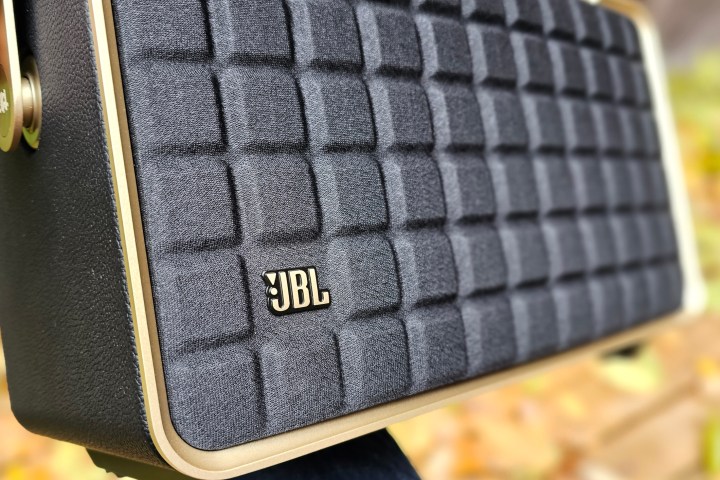
So if you can stream from any music app using AirPlay, Chromecast, or Alexacast, or even Bluetooth — not to mention Tidal Connect and Spotify Connect — why care whether your favorite streaming service is supported natively in the JBL One app?
I can think of three reasons. First: The Moments button is tied to the JBL One app. If your favorite service isn’t among the ones that the app supports natively, you won’t be able to assign a favorite playlist to the button.
Second: It may be the only way to hear your music at the highest possible sound quality. Admittedly, it’s a bit of an edge case, but hypothetically, if you’re an Amazon Music subscriber and you’ve elected not to enable Google Assistant (and thus Chromecast) or Amazon Alexa, you’ll be left with Bluetooth (Android and iOS) or Apple AirPlay (iOS only) as your only non-native streaming options. Since both AirPlay and Bluetooth are limited in terms of stream quality (Bluetooth is much more limited than AirPlay), streaming Amazon Music from within the JBL One app ensures that you’re getting the best lossless audio that Amazon Music can provide, right up to hi-res audio 24-bit resolution.
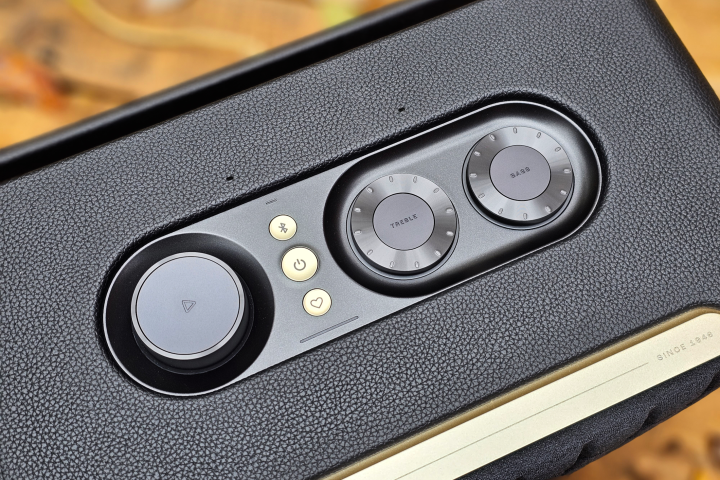
Third — and this might be the most practical reason to use the JBL One app: You can play any music that’s supported, close the JBL One app, and it will keep playing. You can even leave the house entirely. And if anyone else in your home wants to control the music, all they have to do is fire up the JBL One app on their device, and they’ll have full access to your Authentics 300 (or any other JBL speaker managed by that app). This is more or less the same system that Sonos uses.
Streaming via Chromecast built-in, AirPlay, or Bluetooth is based on the availability of the source device, e.g. your phone. If you close your music app, shut down your phone, or simply go to the store for some provisions, your music goes away.
Are these strong reasons for using the JBL One app? Maybe. But I suspect these reasons will grow over time as JBL figures out how to support more music services, multiroom audio, universal search, and universal playlists right in the app — in other words, as it matches more of the things that Sonos already does.
JBL Authentics 300: multiroom audio
- 1. AirPlay instructions
- 2. AirPlay speaker selection.
- 3. Apple Home app.
Though I’m not a fan of JBL outsourcing its multiroom functionality for the Authentics speakers to Google Home and Amazon Alexa, it works. It’s not nearly as easy or as intuitive as the native systems created by Sonos, Denon/HEOS, or Bluesound. But if you enable the appropriate voice assistant, add the Authentics speaker to the appropriate app, and then create speaker groups, you can reliably get multiple speakers to play in sync.
Apple users may simply want to forego all of that and just use AirPlay. It won’t let you stream a different song to each speaker (unless you use multiple iOS devices), but for individual speaker playback or synced audio across multiple speakers, it’s very reliable.
All of this might be a temporary situation for Authentics owners. On November 27, 2023, Harman (JBL’s parent company) announced it had acquired Roon, the music management and multiroom audio service favored by audiophiles. Once Harman brings Roon in-house, it wouldn’t be surprising to see the Authentics benefit from the platform.
JBL Authentics 300: smart voice assistants

I’m still not sure how many folks will benefit from being able to run Google Assistant and Amazon Alexa simultaneously on the same speaker, but big props to JBL nonetheless for making it an option — and making it work — before anyone else.
Setting up each assistant follows the same procedure as it does on other smart speakers (basically logging into Google or Amazon and assenting to connect your account to JBL) and the result is the same — utter the relevant wake word and your chosen AI responds in kind.
Both assistants will acknowledge wake words by illuminating an LED on the front grille of the speaker (white for Googe Assistant, blue for Alexa), but with Alexa, you can additionally enable start- and end-request tones.

Each assistant behaves exactly as you’d expect, faithfully responding to commands, even from across the room with the volume turned up to 50%. However, they don’t really get along all that well. If I asked Google Assistant to play music and then asked Alexa what was playing, it would tell me the last track Alexa played — not the currently playing track. It could stop the music though.
Google Assistant is even more flummoxed when it comes to Alexa-initiated music — it couldn’t identify the currently playing track or stop the music when asked. It’s almost as though as far as Google Assistant was concerned, if it didn’t initiate playback, there was simply nothing playing.
More bizarrely, If I asked Google Assistant to play music and then asked Alexa to skip to the next track, Google Assistant lost the plot entirely, and couldn’t take any further action on the music being played. I had to get Alexa to stop the stream so that Google Assistant could begin anew.
So if you want to have both assistants do your bidding for things like reminders, fact checks on your favorite celebs, or to get an ingredient list for a killer Caesar salad, go nuts. Just don’t ask them to share DJ duties.
Keep in mind that both Google Assistant and Amazon Alexa require an internet connection.
JBL Authentics 300: sound quality

The Authentics 300 delivers clear and detailed sound, with very good midrange definition and a generous soundstage. With two tweeters and a single woofer, you even get convincing stereo sound if you stand in the speaker’s sweet spot (about 5 to 6 feet away).
The catch is that you really can’t experience the speaker’s full potential at volume levels lower than 50%. Below that it feels choked off, especially in the mids and lows. Kick drums and bass lines are especially affected. This is where the Sonos Move 2 has an advantage — Sonos has always managed to extract excellent bass from its speakers even at lower volumes and the Move 2 sounds fuller and more resonant in the lower half of its volume scale.
But open the Authentics 300 up to at least 60% and it springs to life. Bass acquires its missing authority, and the entire sound signature takes on a dynamic, energetic vibe that complements a wide variety of genres.
JBL’s tuning tends to put a lot of emphasis on the highs — so much so, that I needed to dial down the treble almost to its lowest level. This was true even with the Authentics’ automatic self-tuning feature enabled.
With a 100-watt amp driving things, the Authentics 300 can get impressively loud. For most indoor parties, it’s the only speaker you’ll need. Outdoors, unless you’re hosting a really big crowd, the 300 is more than capable of keeping your guests entertained.
JBL Authentics 300: battery life

JBL says you’ll get about 8 hours of playtime from a fully charged Authentics 300, but this can be a highly fluid number. Wi-Fi, for instance, is very energy-hungry compared to Bluetooth. So if you run the speaker on battery power while at home, when connected to Wi-Fi, simply having it turned on will suck battery capacity whether you’re playing music or not.
If you want to get the full eight hours, you’ll need to use just Bluetooth and keep the volume set well below the 50% mark.
Most of the time, when it comes to portable speakers, battery life isn’t a huge concern because you can usually plug the speaker into the USB port of your laptop, or a power bank to get it back up to full capacity. But there’s only one way to charge the Authentics 300: use the included power cord to plug it directly into a wall socket. That’s worth keeping in mind if you’re planning to take it with you to a picnic or any other event where AC power will be hard to come by.
The JBL Authentics 300 is an eye-catching portable speaker with an impressive array of features and the ability to run the two leading voice assistants side-by-side. Its powerful amp makes it a force to be reckoned with when listening loud, but it can lose some of its superb sound when you want a more intimate vibe.
JBL seems to have aspirations to compete with Sonos when it comes to multiroom audio, but its current dependence on third-party platforms like AirPlay, Google Home, and Amazon Alexa, the absence of native support for big services like Apple Music and Spotify, and the lack of a universal music search keeps it from being a true contender.








